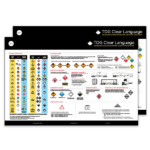On Saturday, December 11, 2021, Transport Canada published a proposed update to Part 6, the training requirements in the “Transportation of Dangerous Goods Regulations” (TDGR), in Canada Gazette, Part I. These standards, if implemented, will create a significant change to the training system and implement a version of Competency-Based Training which has been gaining prominence in regulatory circles over the past few years.
What Is Competency-Based Training?
First, what exactly is Competency-Based Training (CBT)? As explained by Bridget Miller of HR Daily Advisor, “competency-based training is a type of training that is focused on specific competencies or skills…The skills are put together into modules, and typically at the end the learner receives some form of qualification or certification.” In essence, it is a systematic approach to training, that breaks jobs down into individual functions, and ensures that employees are trained and competent in each essential part of their jobs. Also, evaluation should be granular enough to verify that the employees have indeed become competent in their job functions, and are able to do these functions both legally and safely.
To enable Canadian employers to more easily develop job function analyses and evaluation plans, the Canadian General Standards Board (CGSB) has published a standard for competency-based training for transporting dangerous goods. You can download a free copy of this standard, CAN/CGSB-192.3-2020, Transportation of dangerous goods training, assessment and competency, from Government of Canada Publications here. This provides a detailed breakdown of what is required for both general awareness training and job-specific training for both surface and air transport, as well as specific guidance on how to evaluate the success of the training program.
What Are the Changes?
So, all that’s left is for the TDG Regulations to make it official that Canadian dangerous goods training programs must comply with the CGSB standard. This is the goal of the Gazette I proposal. It will do three main things:
- remove the current term “adequately trained” from Part 6 of TDG, which is vague and subject to various interpretations;
- incorporate CAN/CGSB-192.3 by reference, making it a replacement for “adequately trained” as determined without guidance by the employer; and
- establish that to be considered competent to handle, offer for transport or transport dangerous goods, a person must receive two types of training – general awareness (training to understand the basic purpose and concepts of TDG) and function-specific training (training in the requirements of the individual’s job) and assessment.
The Gazette I proposal goes into a deep dive in its preliminary part, which describes the anticipated changes and estimated costs to stakeholders. The actual amendment itself is relatively short since most of the requirements will be covered by reference to the CGSB standard. The proposal will require an amendment to TDG Part 6, Training, to require that training be conducted and evaluated according to that standard. Other changes will be based on the outcome of that standard – for example, training certificates would have to list the competencies a worker is approved for in a slightly different format from a current training certificate.
Record-keeping for training must be upgraded under the new standard. Currently, the employer must keep a record of who was trained, the materials used for training, and a copy of the certificate issued to those who were judged to have become “adequately trained.” Formalized evaluation was done by many employers, but it wasn’t required by Part 6. Under the amendment, “(e)mployers would need to retain records that demonstrate that employees have been trained and assessed in accordance with the CGSB standard, for two years after the expiration of the certificate of competency.” Therefore, employers must make sure their evaluations are documented and maintained with the other records.
Possibly the largest change to training would be the division of “general awareness” from “job-specific” training. Although the amendment doesn’t mention it directly, the CGSB standard requires that workers must pass a detailed test on the general awareness portion before moving on to job-specific. This may require splitting the training into two separate sections, since those who fail the general awareness evaluation may only repeat the test two more times. If they don’t pass after the third attempt, they must repeat the general awareness training and keep retesting until they can pass before they move on to job-specific. Since most current training courses combine the two sections into one session, this means training procedures will require some rethinking, and possibly new concepts must be used.
What Is the Timeframe?
Remember that this isn’t a final version of the amendment – it is a proposal for public comment. It doesn’t become finalized until it’s published (with any necessary changes due to comments) in Canada Gazette II. Transport Canada invites interested persons to make representations within 60 days of the date of publication (December 11, 2021). These comments must cite the Canada Gazette, Part I, and the date of publication of the notice. If you want to make comments, address them to:
Geneviève Sansoucy,
Chief Scientific Regulatory Development, Regulatory Frameworks and International Engagement Branch,
Transportation of Dangerous Goods Directorate, Department of Transport,
300 Laurier Avenue West, Ottawa, K1A 1J2
Email: [email protected]
Of course, after the sixty days, Transport Canada must read and evaluate the public comments, so it is unlikely at the fastest the Canada Gazette, Part II, version would be out before spring of 2022, and it may be later than that. When it does become official, there will be a transitional period of a year before new training must be conducted under the CGSB standard. Also, the change will not affect those with current training certificates. Those will remain valid until they expire – then, the refresher training and certification must be conducted according to the new standard. But the timeframe is still short enough that those involved in training need to start considering the implications soon.
Of course, we at ICC The Compliance Center will be able to assist you with your training needs. For example, under the new standard, we can help you conduct your job evaluations using the new standard and advise you what your staff will require in both general awareness and job-specific training. If you want to discuss your training needs, contact our regulatory experts at 1-888-977-4834 (Canada). We’ll be happy to set you on the path to ensuring competency and compliance.
Sources:
Canada Gazette, Part I, Volume 155, No. 50
CAN/CGSB-192.3-2020, Transportation of dangerous goods training, assessment and competency
Miller, Bridget, HR Daily Advisor, What is Competency-Based Training?
Stay up to date and sign up for our newsletter!
We have all the products, services and training you need to ensure your staff is properly trained and informed.
 Canadian Transportation of Dangerous Goods (TDG) Regulations in Clear Language, English |
 Shipping Dangerous Goods by Ground in Canada |
 Shipping by Ground – TDG Posters & Charts |






